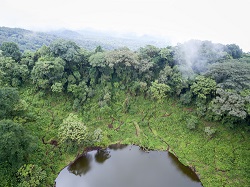Antimalarial and anticancer drugs from Cameroonian plants
Modern medicine as we have come to know it has been evolving so rapidly that we may sometimes forget how young it is. Traditional herbal medicine, on the other hand, has been around for centuries and relies on compounds that have been adapting to environmental threats for thousands of years. Whilst both fields may seem worlds apart, bridging the gap only requires meticulous scientific studies and a drug development process able to preserve the benefits of these raw materials. Prof. Jean-Claude Ndom is one of many researchers personifying the link between modern medicine and its traditional, plant-based counterpart. With funding under the PLANTMEDS (Potential Antimalarial and Anticancer Lead Compound Discovery from Cameroonian Medicinal Plants) project, he spent two years in Cameroon trying to identify antimalarial and anticancer active molecules for new drug development from plants. “A good number of molecules found in plants show a great diversity of bioactive properties –when directed not only towards threats to the plant but also towards malaria, cancers and other human diseases,” he explains. “The Cameroonian rainforest offers a first-grade source of such novel molecular structures and bioactive compounds from plant material, being one of the most biologically diverse ecosystems on earth.” In Cameroon, people have been using rainforest plants since ancient times for medical recipes developed after hundreds of years of trial and error, and some of them – Rutaceae and Simaroubaceae – are traditionally used against malaria and cancers. With his research, Prof. Ndom and his team aimed to find evidence of their benefits with the hope of catching the pharmaceutical industry’s attention. “Some 137 plants from 48 families that are employed by traditional healers have never been investigated for their presumed antimalarial properties, and a similar picture can be drawn for anticancer plants and plants used against bacterial infections,” Prof. Ndom notes. “The European pharmaceutical industry decided to focus on synthetic chemistry and high throughput screening (HTS) instead, and it failed.” The result of this failure and accelerating drug resistance has been a paradigm shift towards natural products, and PLANTMEDS played its part by questioning traditional healers, collecting plants and extracting their most promising compounds by applying chromatographic methods of column chromatography and high performance liquid chromatography (HPLC) assisted by antimalarial / anticancer bioassays. “Once isolated, pure compounds are subjected to structural characterisation by various spectroscopic methods; bioactivity assays combined with toxicity assessment employing human cell lines are carried out; promising compounds are subjected to semisynthetic reactions coupled with bioassays/toxicity assays to improve molecule properties (higher active, lower toxic); and an assessment of structure – activity relationship (QSAR) is done to select the identified leads for pharmaceutical pre-formulation and formulation studies.” The results were promising. Compounds isolated from the stem bark of Citrus reticulata led to synergistic effects of at least two cancers: Significant activity was observed from an extract against the breast cancer cell line MCF7, and a chromatographic fraction displayed extremely low 50 % inhibition concentration values against the human lung adenocarcinoma cell line A549; human breast adenocarcinoma cell line MCF7 and human Caucasian prostate adenocarcinoma cell line PC3. “Importantly, assays employing a normal human cell line indicated very low toxicity of this chromatographic fraction,” Prof. Ndom points out. Although the project was completed at the end of 2016, the team have been continuing their work, notably proceeding with antimalarial tests for parts of Hannoa ferruginea. They also have plans to assay mixtures of seven compounds from the active stem bark fraction of Citrus reticulata, to identify the composition displaying the highest activity and lowest toxicity. “The most promising compositions will then be combined with current lung, breast and prostate cancer drugs in various mixtures to identify those with highest activity / lowest toxicity in vitro. This will be followed by acute / chronic toxicity assessment in animal models for best drug candidates, and, once passing the in vivo assessment phase successfully, clinical trials will be considered,” says Prof. Ndom.
Keywords
PLANTMEDS, Cameroon, rainforest, herbal medicine, cancer, malaria, compounds, Hannoa ferruginea, Citrus reticulata







